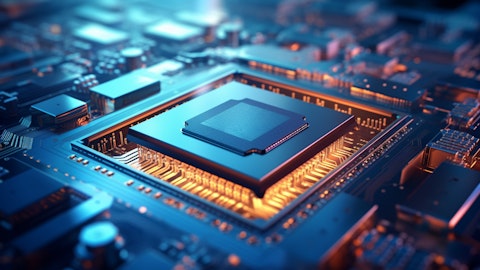Taiwan Semiconductor Manufacturing Company Limited (NYSE:TSM) Q1 2024 Earnings Call Transcript April 18, 2024
Operator:
Jeff Su: Good afternoon, everyone, and welcome to TSMC’s First Quarter 2024 Earnings Conference Call. This is Jeff Su, TSMC’s Director of Investor Relations and your host for today. TSMC is hosting our earnings conference call via live audio webcast through the company’s website at www.tsmc.com, where you can also download the earnings release materials shortly. [Operator Instructions]. The format for today’s event will be as follows: first, TSMC’s Senior Vice President and CFO, Mr. Wendell Huang, will summarize our operations in the first quarter 2024, followed by our guidance for the second quarter 2024. Afterwards, Mr. Huang and TSMC’s CEO, Dr. C. C. Wei, will jointly provide the company’s key messages. Then we will open the lines for the question-and-answer session.

As usual, I would like to remind everybody that today’s discussions may contain forward-looking statements that are subject to significant risks and uncertainties, which could cause actual results to differ materially from those contained in the forward-looking statements. Please refer to the safe harbor notice that appears on our press release. And now I would like to turn the call over to TSMC’s CFO, Mr. Wendell Huang, for the summary of operations and the current quarter guidance.
Wendell Huang: Thank you, Jeff. Good afternoon, everyone. Thank you for joining us today. My presentation will start with the financial highlights for the first quarter 2024. After that, I will provide the guidance for the second quarter 2024. First quarter revenue decreased 5.3% sequentially in NT dollars or 3.8% in U.S. dollars as our business was impacted by smartphone seasonality, partially offset by continued HPC-related demand. Gross margin increased 0.1 percentage point sequentially to 53.1%, mainly reflecting product mix changes due to smartphone seasonality, partially offset by a less favorable foreign exchange rate. Total operating expenses accounted for 11.1% of net revenue, which is lower than the 12% implied in our first quarter guidance, mainly due to tighter expense controls.
Thus, operating margin increased 0.4 percentage points sequentially to 42%. Overall, our first quarter EPS was TWD8.7 and ROE was 25.4%. Now let’s move on to revenue by technology. 3-nanometer process technology contributed 9% of wafer revenue in the first quarter, whilst 5-nanometer and 7-nanometer accounted for 37% and 19%, respectively. Advanced technologies, defined as 7-nanometer and below, accounted for 65% of wafer revenue. Moving on to revenue contribution by platform. HPC increased 3% quarter-over-quarter to account for 46% of our first quarter revenue. Smartphone decreased 16% to account for 38%. IoT increased 5% to account for 6%. Automotive remained flat and accounted for 6%, and DCE increased 33% to account for 2%. Moving on to the balance sheet.
See also 15 Best Low Cost ETFs and 14 Best Large Cap Dividend Growth Stocks To Buy Now.
Q&A Session
Follow Taiwan Semiconductor Mfg Co Ltd (NYSE:TSM)
Follow Taiwan Semiconductor Mfg Co Ltd (NYSE:TSM)
We ended the first quarter with cash and marketable securities of TWD1.9 trillion or USD 60 billion. On the liability side, current liabilities increased by TWD113 billion, mainly due to the increase of TWD140 billion in accrued liabilities and others, partially offset by the decrease of TWD44 billion in accounts payable. The increase in accrued liabilities and others was mainly due to the reclassification of the temporary receipt from customers from long-term liabilities. Our financial ratios, accounts receivable turnover days remained at 31 days, while days of inventory increased 5 days to 90 days, primarily due to ramp of 3-nanometer technologies. Regarding cash flow and CapEx. During the first quarter, we generated about TWD436 billion in cash from operations, spent TWD181 billion in CapEx and distributed TWD78 billion for second quarter 2023 cash dividend.
In addition, we raised TWD23 billion in cash from bond issuances. Overall, our cash balance increased TWD233 billion to TWD1.7 trillion at the end of the quarter. In U.S. dollar terms, our first quarter capital expenditures totaled $5.77 billion. I have finished my financial summary. Now let’s turn to our current quarter guidance. We expect our business to be supported by strong demand for our industry-leading 3-nanometer and 5-nanometer technologies, partially offset by continued smartphone seasonality. Based on the current business outlook, we expect our second quarter revenue to be between USD 19.6 billion and USD 20.4 billion, which represents a 6% sequential increase and 27.6% year-over-year increase at the midpoint. Based on the exchange rate assumption of USD 1 to TWD32.3, gross margin is expected to be between 51% and 53%, operating margin between 40% and 42%.
Also, in the second quarter, we will need to accrue the tax on the undistributed retained earnings. As a result, our second quarter tax rate will be slightly above 19%. The tax rate will then fall back to 13% to 14% level in the third and fourth quarter, and the full year tax rate will be between 15% to 16% compared to 14.5% in 2023. This concludes my financial presentation. Now let me turn to our key messages. I will start by making some comments on the impact from the April 3 earthquake. On April 3, an earthquake of 7.2 magnitude struck Taiwan, and the maximum magnitude of our fabs was 5. Safety systems and protocols at our fabs were initiated immediately, and all TSMC personnel are safe. Based on TSMC’s deep experience and capabilities in earthquake response and damage prevention as well as regular disasters drills, the overall tool recovery in our fabs reached more than 70% within the first 10 hours and were fully recovered by the end of the third day.
There were no power outages, no structural damage to our fabs, and there’s no damage to our critical tools, including all of our EUV lithography tools. That being said, a certain number of wafers in process were impacted and had to be scrapped, but we expect most of the lost production to be recovered in the second quarter and, thus, minimum impact to our second quarter revenue. We expect the total impact from the earthquake to reduce our second quarter gross margin by about 50 basis points, mainly due to the losses associated with wafer scraps and material loss. Next, let me talk about our first quarter ’24 and second quarter ’24 profitability. Compared to fourth quarter 2023, our first quarter gross margin slightly increased by 10 basis points sequentially to 53.1%, primarily driven by product mix changes due to smartphone seasonality.
We have just guided our second quarter gross margin to decline by 1.1 percentage points to 52% at the midpoint, primarily due to the impact from the earthquake on April 3, as just discussed, and higher electricity cost in Taiwan. After last year’s 17% electricity price increase from April 1, TSMC’s electricity price in Taiwan has increased by another 25% starting April 1 this year. This is expected to take out 70 to 80 basis points from our second quarter gross margin. Looking ahead to the second half of the year, we expect the impact from higher electricity cost to continue and dilute our gross margin by 60 to 70 basis points. We also expect the higher electricity cost to indirectly lead to higher materials, chemical and gases and other variable costs.
In addition, we expect our overall business in the second quarter of the year to be stronger than the first half. And the revenue contribution from 3-nanometer technologies is expected to increase as well, which will dilute our gross margin by 3 to 4 percentage points in second half of ’24 as compared to 2 to 3 percentage points in first half of ’24. Finally, as we have said before, we have a strategy to convert some 5-nanometer tools to support 3-nanometer capacity given the strong multiyear demand. We expect this conversion to dilute our gross margin by about 1 to 2 percentage points in the second half of 2024. To manage our profitability in second half 2024, we will work diligently on internal cost improvement efforts while continuing to sell our value.
Longer term, excluding the impact of foreign exchange rate and considering our global manufacturing footprint expansion plans, we continue to forecast a long-term gross margin of 53% and higher is achievable.
Jeff Su: Okay. Sorry to interrupt, Wendell, because we have been informed that some of the audience are having difficulty linking through the website to the call. So let’s pause a few minutes, and we’ll continue once we resolve the IT issue. Thank you, everyone, for your patience. [Technical Difficulty] on the telephone call, sorry, we’re having a little bit of IT issue. We should expect hopefully to resolve it very soon. So just please hang on for a few more minutes, and thank you for your patience. Okay. Thank you, everyone, for your patience. Sorry about the technical issues. We believe the webcast, if you’re through the TSMC website, you should be able to log back in and listen to the webcast. For those of you on the line or having difficulty with the telephone, I think try the webcast first and the telephone line should be available shortly.
Again, sorry for the inconvenience, and thank you for the patience. In light of the fact that we had these technical issues, I think we’ll start with Wendell Huang, our CFO, to give our guidance, and then we will go into our prepared remarks. Thank you.





